Analysis of Lean Production System in the UK Automotive Industry
VerifiedAdded on 2019/09/19
|19
|4712
|441
Report
AI Summary
This report delves into the lean production system within the UK automotive industry, exploring its origins in Japanese manufacturing philosophies and its evolution from craft to mass production. It examines the historical context of lean manufacturing, contrasting it with traditional mass production methods and highlighting the significance of concepts like Just-in-Time and the Toyota Production System. The report investigates the models, techniques, and processes involved in lean production, including the reduction of inventory, elimination of waste, and the importance of employee involvement. Furthermore, it analyzes the pros and cons of implementing lean production in the automotive sector, addressing challenges such as investment costs and scalability. The report also answers the research questions, providing insights into the process, models, techniques, prospects, and constraints of the lean production system in the UK automotive industry.
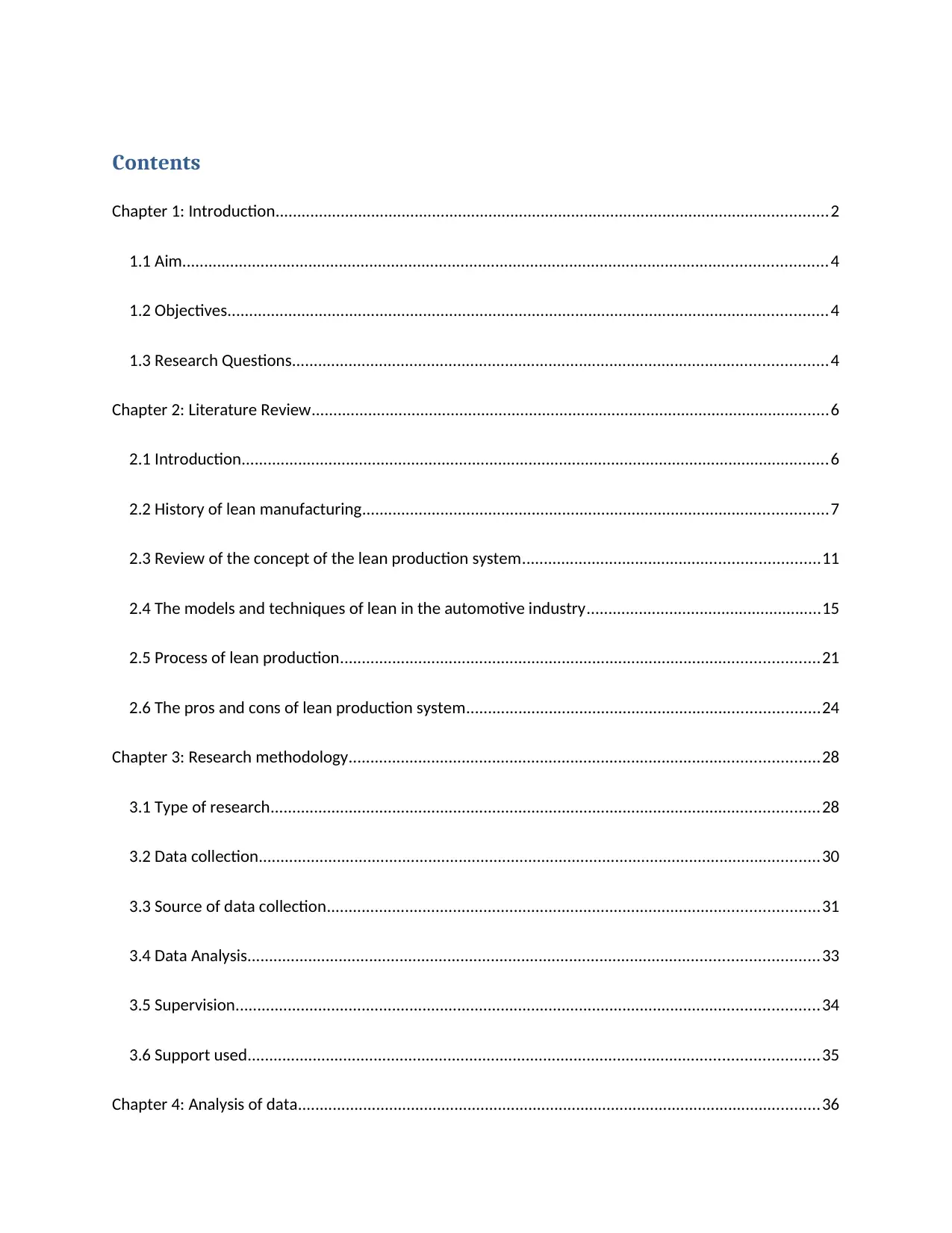
Contents
Chapter 1: Introduction...............................................................................................................................2
1.1 Aim....................................................................................................................................................4
1.2 Objectives..........................................................................................................................................4
1.3 Research Questions...........................................................................................................................4
Chapter 2: Literature Review.......................................................................................................................6
2.1 Introduction.......................................................................................................................................6
2.2 History of lean manufacturing...........................................................................................................7
2.3 Review of the concept of the lean production system....................................................................11
2.4 The models and techniques of lean in the automotive industry......................................................15
2.5 Process of lean production..............................................................................................................21
2.6 The pros and cons of lean production system.................................................................................24
Chapter 3: Research methodology............................................................................................................28
3.1 Type of research..............................................................................................................................28
3.2 Data collection.................................................................................................................................30
3.3 Source of data collection.................................................................................................................31
3.4 Data Analysis...................................................................................................................................33
3.5 Supervision......................................................................................................................................34
3.6 Support used...................................................................................................................................35
Chapter 4: Analysis of data........................................................................................................................36
Chapter 1: Introduction...............................................................................................................................2
1.1 Aim....................................................................................................................................................4
1.2 Objectives..........................................................................................................................................4
1.3 Research Questions...........................................................................................................................4
Chapter 2: Literature Review.......................................................................................................................6
2.1 Introduction.......................................................................................................................................6
2.2 History of lean manufacturing...........................................................................................................7
2.3 Review of the concept of the lean production system....................................................................11
2.4 The models and techniques of lean in the automotive industry......................................................15
2.5 Process of lean production..............................................................................................................21
2.6 The pros and cons of lean production system.................................................................................24
Chapter 3: Research methodology............................................................................................................28
3.1 Type of research..............................................................................................................................28
3.2 Data collection.................................................................................................................................30
3.3 Source of data collection.................................................................................................................31
3.4 Data Analysis...................................................................................................................................33
3.5 Supervision......................................................................................................................................34
3.6 Support used...................................................................................................................................35
Chapter 4: Analysis of data........................................................................................................................36
Paraphrase This Document
Need a fresh take? Get an instant paraphrase of this document with our AI Paraphraser

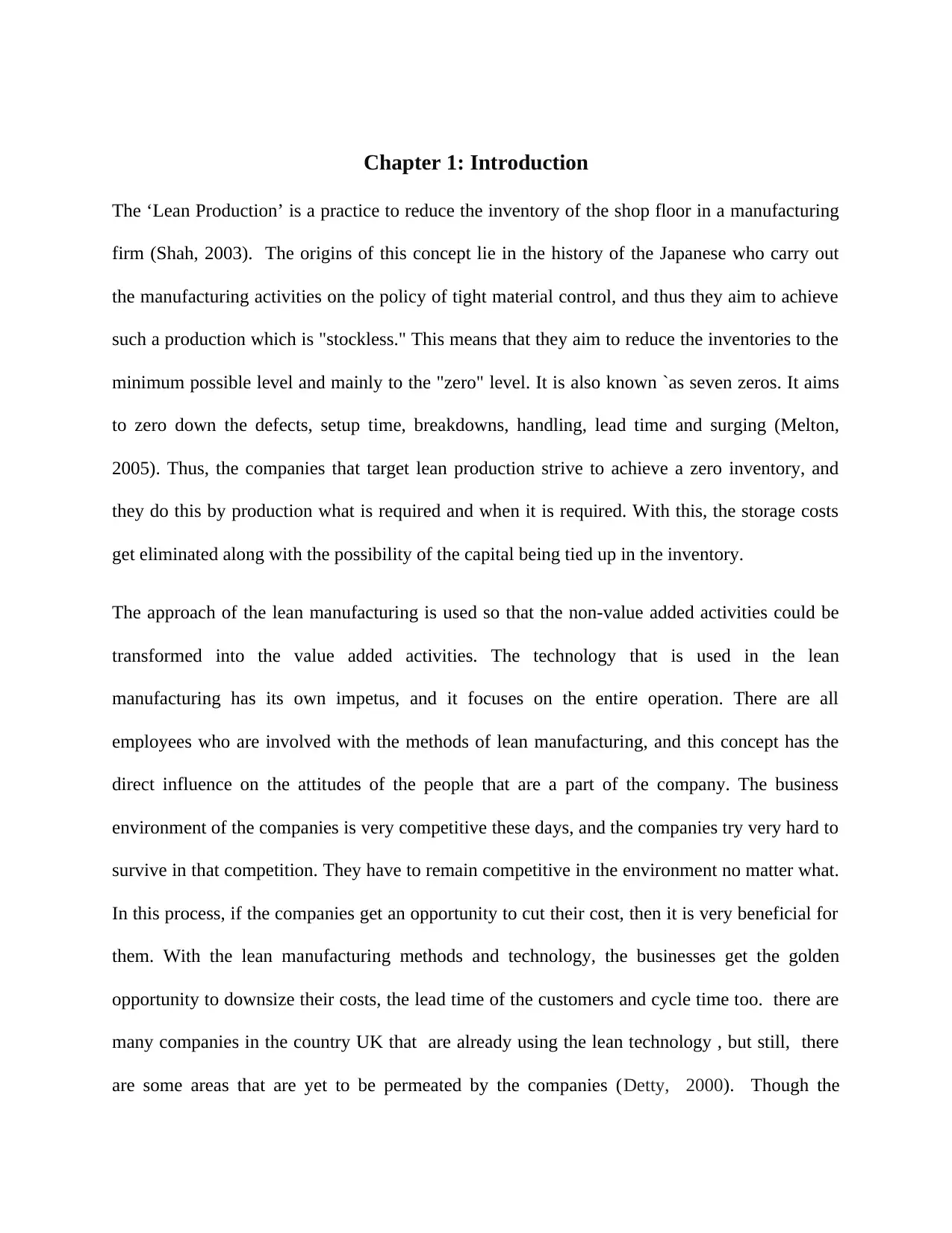
Chapter 1: Introduction
The ‘Lean Production’ is a practice to reduce the inventory of the shop floor in a manufacturing
firm (Shah, 2003). The origins of this concept lie in the history of the Japanese who carry out
the manufacturing activities on the policy of tight material control, and thus they aim to achieve
such a production which is "stockless." This means that they aim to reduce the inventories to the
minimum possible level and mainly to the "zero" level. It is also known `as seven zeros. It aims
to zero down the defects, setup time, breakdowns, handling, lead time and surging (Melton,
2005). Thus, the companies that target lean production strive to achieve a zero inventory, and
they do this by production what is required and when it is required. With this, the storage costs
get eliminated along with the possibility of the capital being tied up in the inventory.
The approach of the lean manufacturing is used so that the non-value added activities could be
transformed into the value added activities. The technology that is used in the lean
manufacturing has its own impetus, and it focuses on the entire operation. There are all
employees who are involved with the methods of lean manufacturing, and this concept has the
direct influence on the attitudes of the people that are a part of the company. The business
environment of the companies is very competitive these days, and the companies try very hard to
survive in that competition. They have to remain competitive in the environment no matter what.
In this process, if the companies get an opportunity to cut their cost, then it is very beneficial for
them. With the lean manufacturing methods and technology, the businesses get the golden
opportunity to downsize their costs, the lead time of the customers and cycle time too. there are
many companies in the country UK that are already using the lean technology , but still, there
are some areas that are yet to be permeated by the companies (Detty, 2000). Though the
The ‘Lean Production’ is a practice to reduce the inventory of the shop floor in a manufacturing
firm (Shah, 2003). The origins of this concept lie in the history of the Japanese who carry out
the manufacturing activities on the policy of tight material control, and thus they aim to achieve
such a production which is "stockless." This means that they aim to reduce the inventories to the
minimum possible level and mainly to the "zero" level. It is also known `as seven zeros. It aims
to zero down the defects, setup time, breakdowns, handling, lead time and surging (Melton,
2005). Thus, the companies that target lean production strive to achieve a zero inventory, and
they do this by production what is required and when it is required. With this, the storage costs
get eliminated along with the possibility of the capital being tied up in the inventory.
The approach of the lean manufacturing is used so that the non-value added activities could be
transformed into the value added activities. The technology that is used in the lean
manufacturing has its own impetus, and it focuses on the entire operation. There are all
employees who are involved with the methods of lean manufacturing, and this concept has the
direct influence on the attitudes of the people that are a part of the company. The business
environment of the companies is very competitive these days, and the companies try very hard to
survive in that competition. They have to remain competitive in the environment no matter what.
In this process, if the companies get an opportunity to cut their cost, then it is very beneficial for
them. With the lean manufacturing methods and technology, the businesses get the golden
opportunity to downsize their costs, the lead time of the customers and cycle time too. there are
many companies in the country UK that are already using the lean technology , but still, there
are some areas that are yet to be permeated by the companies (Detty, 2000). Though the
⊘ This is a preview!⊘
Do you want full access?
Subscribe today to unlock all pages.

Trusted by 1+ million students worldwide
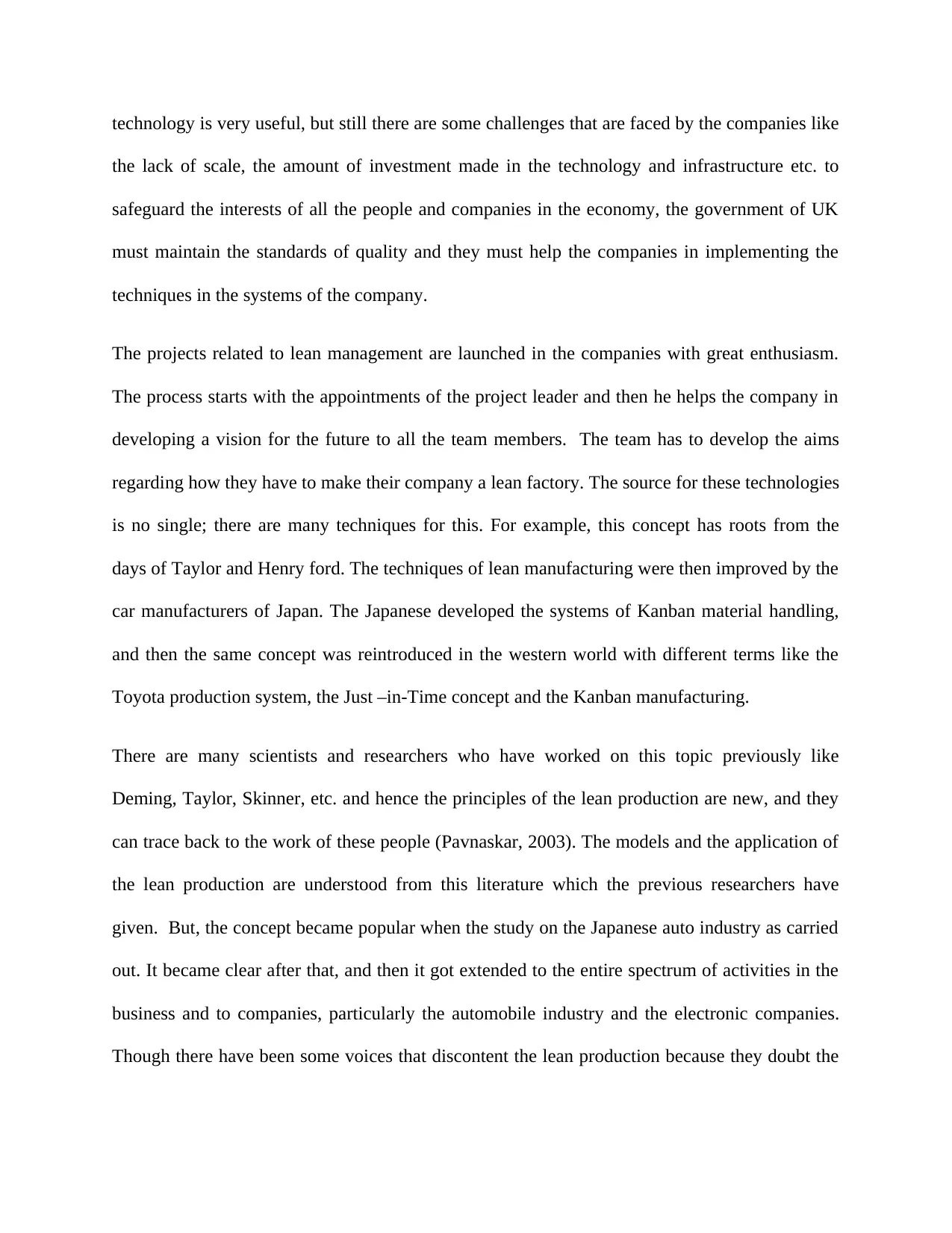
technology is very useful, but still there are some challenges that are faced by the companies like
the lack of scale, the amount of investment made in the technology and infrastructure etc. to
safeguard the interests of all the people and companies in the economy, the government of UK
must maintain the standards of quality and they must help the companies in implementing the
techniques in the systems of the company.
The projects related to lean management are launched in the companies with great enthusiasm.
The process starts with the appointments of the project leader and then he helps the company in
developing a vision for the future to all the team members. The team has to develop the aims
regarding how they have to make their company a lean factory. The source for these technologies
is no single; there are many techniques for this. For example, this concept has roots from the
days of Taylor and Henry ford. The techniques of lean manufacturing were then improved by the
car manufacturers of Japan. The Japanese developed the systems of Kanban material handling,
and then the same concept was reintroduced in the western world with different terms like the
Toyota production system, the Just –in-Time concept and the Kanban manufacturing.
There are many scientists and researchers who have worked on this topic previously like
Deming, Taylor, Skinner, etc. and hence the principles of the lean production are new, and they
can trace back to the work of these people (Pavnaskar, 2003). The models and the application of
the lean production are understood from this literature which the previous researchers have
given. But, the concept became popular when the study on the Japanese auto industry as carried
out. It became clear after that, and then it got extended to the entire spectrum of activities in the
business and to companies, particularly the automobile industry and the electronic companies.
Though there have been some voices that discontent the lean production because they doubt the
the lack of scale, the amount of investment made in the technology and infrastructure etc. to
safeguard the interests of all the people and companies in the economy, the government of UK
must maintain the standards of quality and they must help the companies in implementing the
techniques in the systems of the company.
The projects related to lean management are launched in the companies with great enthusiasm.
The process starts with the appointments of the project leader and then he helps the company in
developing a vision for the future to all the team members. The team has to develop the aims
regarding how they have to make their company a lean factory. The source for these technologies
is no single; there are many techniques for this. For example, this concept has roots from the
days of Taylor and Henry ford. The techniques of lean manufacturing were then improved by the
car manufacturers of Japan. The Japanese developed the systems of Kanban material handling,
and then the same concept was reintroduced in the western world with different terms like the
Toyota production system, the Just –in-Time concept and the Kanban manufacturing.
There are many scientists and researchers who have worked on this topic previously like
Deming, Taylor, Skinner, etc. and hence the principles of the lean production are new, and they
can trace back to the work of these people (Pavnaskar, 2003). The models and the application of
the lean production are understood from this literature which the previous researchers have
given. But, the concept became popular when the study on the Japanese auto industry as carried
out. It became clear after that, and then it got extended to the entire spectrum of activities in the
business and to companies, particularly the automobile industry and the electronic companies.
Though there have been some voices that discontent the lean production because they doubt the
Paraphrase This Document
Need a fresh take? Get an instant paraphrase of this document with our AI Paraphraser
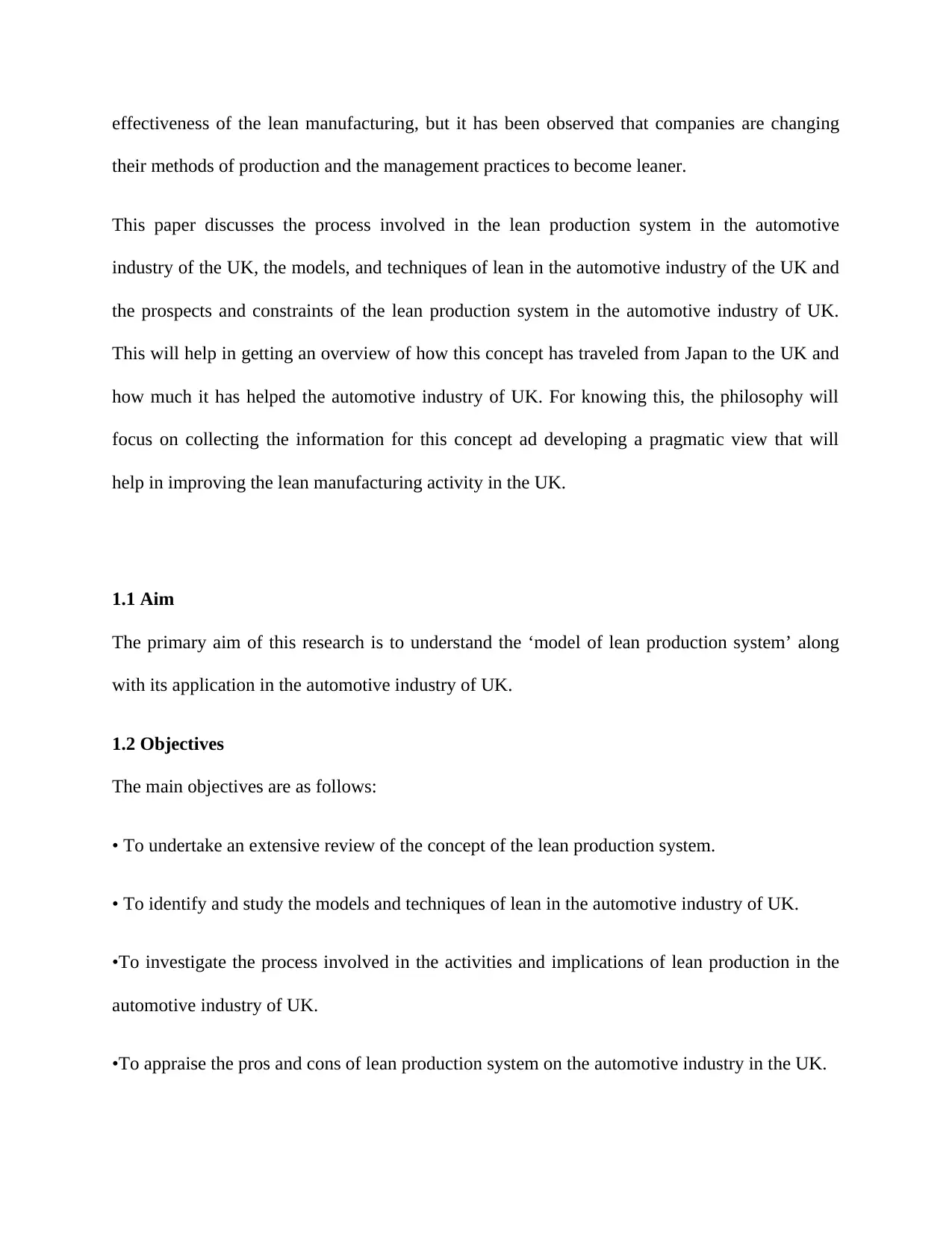
effectiveness of the lean manufacturing, but it has been observed that companies are changing
their methods of production and the management practices to become leaner.
This paper discusses the process involved in the lean production system in the automotive
industry of the UK, the models, and techniques of lean in the automotive industry of the UK and
the prospects and constraints of the lean production system in the automotive industry of UK.
This will help in getting an overview of how this concept has traveled from Japan to the UK and
how much it has helped the automotive industry of UK. For knowing this, the philosophy will
focus on collecting the information for this concept ad developing a pragmatic view that will
help in improving the lean manufacturing activity in the UK.
1.1 Aim
The primary aim of this research is to understand the ‘model of lean production system’ along
with its application in the automotive industry of UK.
1.2 Objectives
The main objectives are as follows:
• To undertake an extensive review of the concept of the lean production system.
• To identify and study the models and techniques of lean in the automotive industry of UK.
•To investigate the process involved in the activities and implications of lean production in the
automotive industry of UK.
•To appraise the pros and cons of lean production system on the automotive industry in the UK.
their methods of production and the management practices to become leaner.
This paper discusses the process involved in the lean production system in the automotive
industry of the UK, the models, and techniques of lean in the automotive industry of the UK and
the prospects and constraints of the lean production system in the automotive industry of UK.
This will help in getting an overview of how this concept has traveled from Japan to the UK and
how much it has helped the automotive industry of UK. For knowing this, the philosophy will
focus on collecting the information for this concept ad developing a pragmatic view that will
help in improving the lean manufacturing activity in the UK.
1.1 Aim
The primary aim of this research is to understand the ‘model of lean production system’ along
with its application in the automotive industry of UK.
1.2 Objectives
The main objectives are as follows:
• To undertake an extensive review of the concept of the lean production system.
• To identify and study the models and techniques of lean in the automotive industry of UK.
•To investigate the process involved in the activities and implications of lean production in the
automotive industry of UK.
•To appraise the pros and cons of lean production system on the automotive industry in the UK.
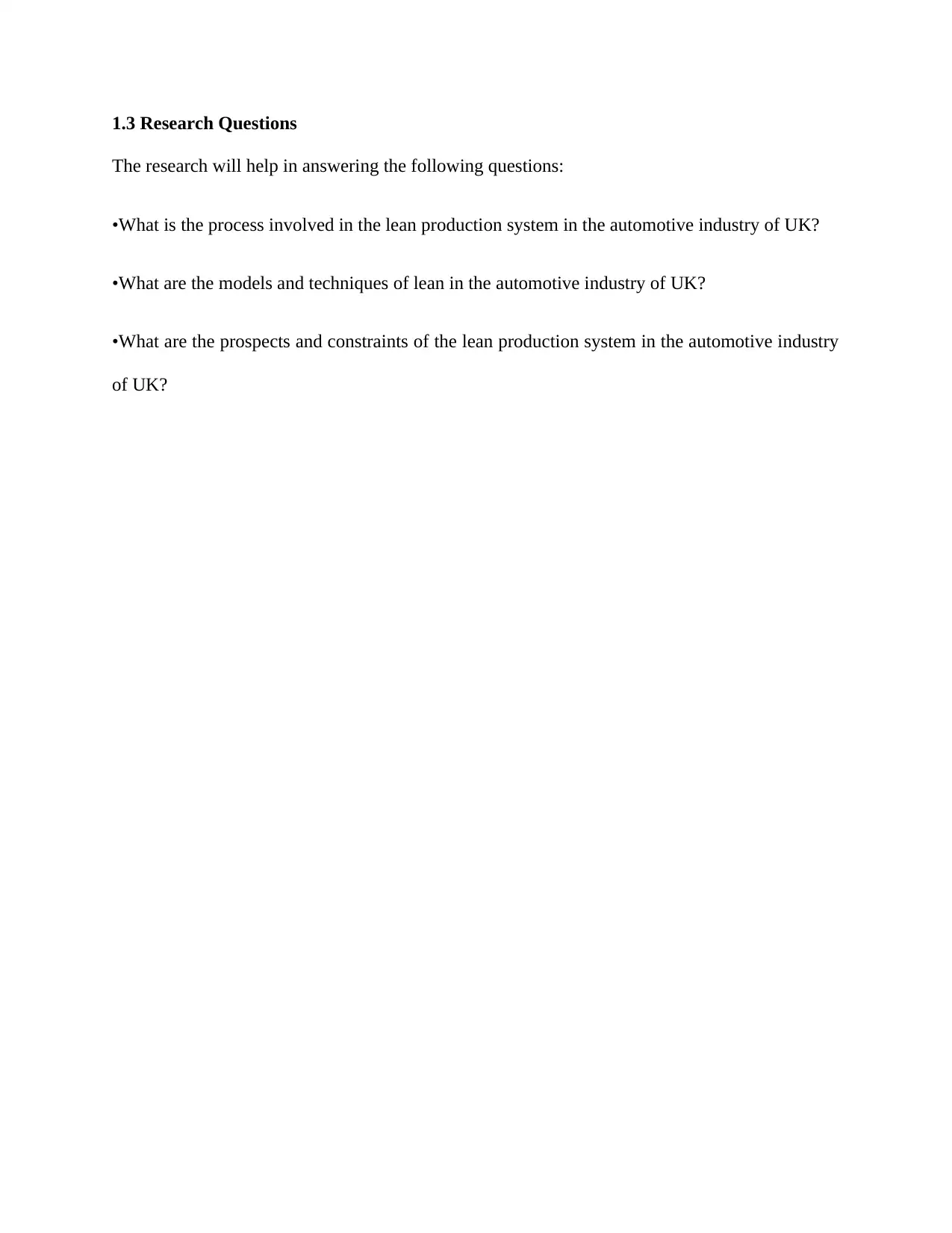
1.3 Research Questions
The research will help in answering the following questions:
•What is the process involved in the lean production system in the automotive industry of UK?
•What are the models and techniques of lean in the automotive industry of UK?
•What are the prospects and constraints of the lean production system in the automotive industry
of UK?
The research will help in answering the following questions:
•What is the process involved in the lean production system in the automotive industry of UK?
•What are the models and techniques of lean in the automotive industry of UK?
•What are the prospects and constraints of the lean production system in the automotive industry
of UK?
⊘ This is a preview!⊘
Do you want full access?
Subscribe today to unlock all pages.

Trusted by 1+ million students worldwide
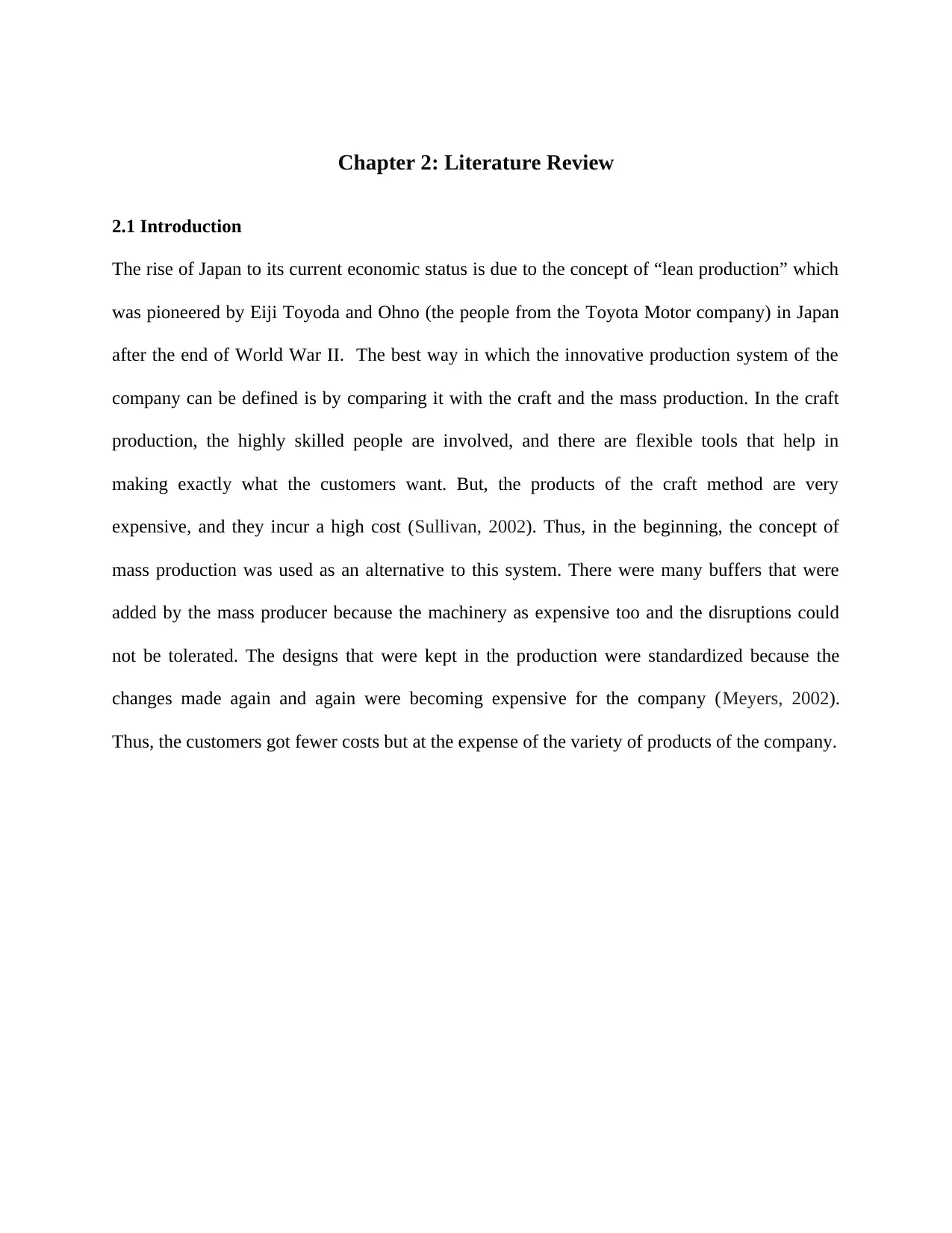
Chapter 2: Literature Review
2.1 Introduction
The rise of Japan to its current economic status is due to the concept of “lean production” which
was pioneered by Eiji Toyoda and Ohno (the people from the Toyota Motor company) in Japan
after the end of World War II. The best way in which the innovative production system of the
company can be defined is by comparing it with the craft and the mass production. In the craft
production, the highly skilled people are involved, and there are flexible tools that help in
making exactly what the customers want. But, the products of the craft method are very
expensive, and they incur a high cost (Sullivan, 2002). Thus, in the beginning, the concept of
mass production was used as an alternative to this system. There were many buffers that were
added by the mass producer because the machinery as expensive too and the disruptions could
not be tolerated. The designs that were kept in the production were standardized because the
changes made again and again were becoming expensive for the company (Meyers, 2002).
Thus, the customers got fewer costs but at the expense of the variety of products of the company.
2.1 Introduction
The rise of Japan to its current economic status is due to the concept of “lean production” which
was pioneered by Eiji Toyoda and Ohno (the people from the Toyota Motor company) in Japan
after the end of World War II. The best way in which the innovative production system of the
company can be defined is by comparing it with the craft and the mass production. In the craft
production, the highly skilled people are involved, and there are flexible tools that help in
making exactly what the customers want. But, the products of the craft method are very
expensive, and they incur a high cost (Sullivan, 2002). Thus, in the beginning, the concept of
mass production was used as an alternative to this system. There were many buffers that were
added by the mass producer because the machinery as expensive too and the disruptions could
not be tolerated. The designs that were kept in the production were standardized because the
changes made again and again were becoming expensive for the company (Meyers, 2002).
Thus, the customers got fewer costs but at the expense of the variety of products of the company.
Paraphrase This Document
Need a fresh take? Get an instant paraphrase of this document with our AI Paraphraser
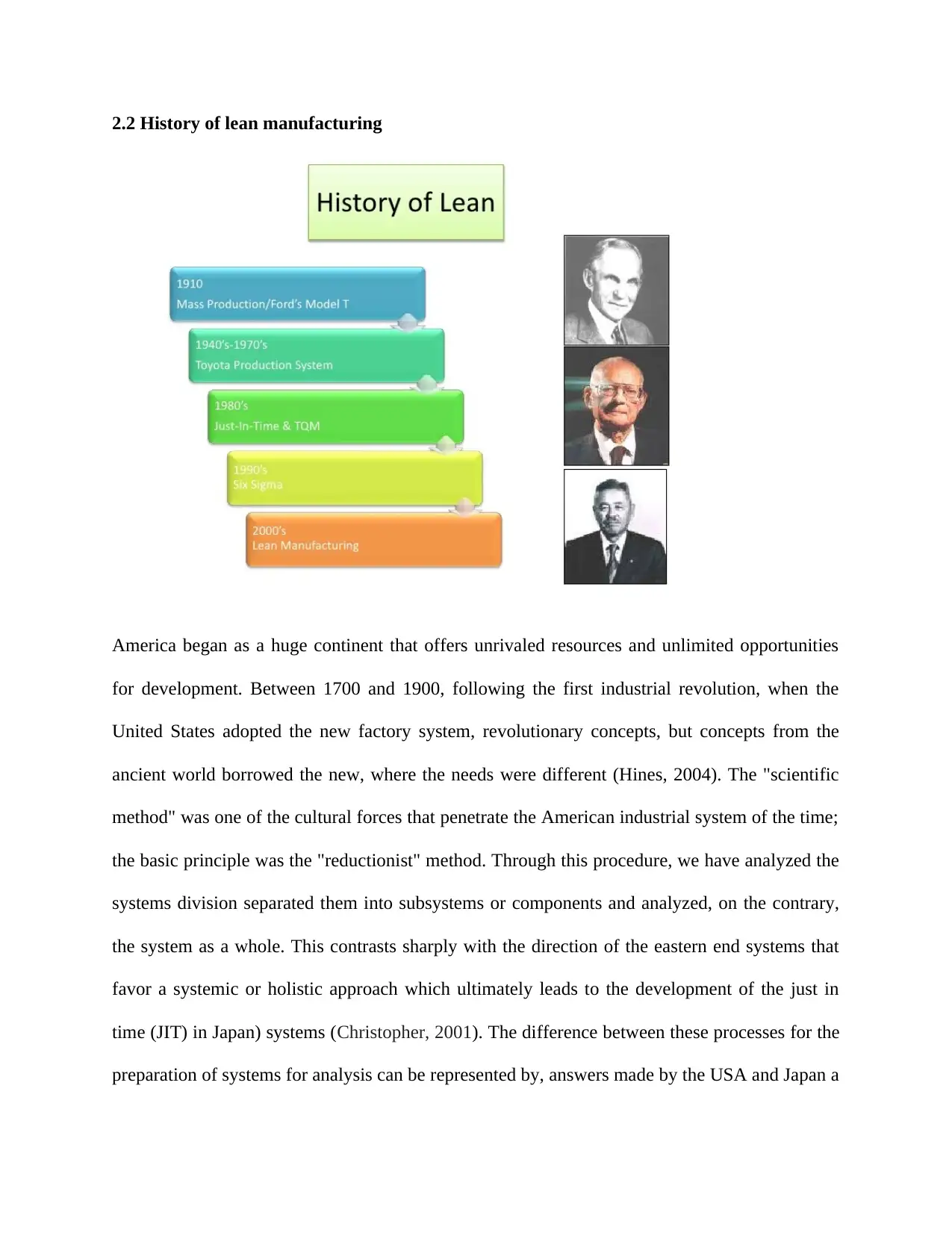
2.2 History of lean manufacturing
America began as a huge continent that offers unrivaled resources and unlimited opportunities
for development. Between 1700 and 1900, following the first industrial revolution, when the
United States adopted the new factory system, revolutionary concepts, but concepts from the
ancient world borrowed the new, where the needs were different (Hines, 2004). The "scientific
method" was one of the cultural forces that penetrate the American industrial system of the time;
the basic principle was the "reductionist" method. Through this procedure, we have analyzed the
systems division separated them into subsystems or components and analyzed, on the contrary,
the system as a whole. This contrasts sharply with the direction of the eastern end systems that
favor a systemic or holistic approach which ultimately leads to the development of the just in
time (JIT) in Japan) systems (Christopher, 2001). The difference between these processes for the
preparation of systems for analysis can be represented by, answers made by the USA and Japan a
America began as a huge continent that offers unrivaled resources and unlimited opportunities
for development. Between 1700 and 1900, following the first industrial revolution, when the
United States adopted the new factory system, revolutionary concepts, but concepts from the
ancient world borrowed the new, where the needs were different (Hines, 2004). The "scientific
method" was one of the cultural forces that penetrate the American industrial system of the time;
the basic principle was the "reductionist" method. Through this procedure, we have analyzed the
systems division separated them into subsystems or components and analyzed, on the contrary,
the system as a whole. This contrasts sharply with the direction of the eastern end systems that
favor a systemic or holistic approach which ultimately leads to the development of the just in
time (JIT) in Japan) systems (Christopher, 2001). The difference between these processes for the
preparation of systems for analysis can be represented by, answers made by the USA and Japan a
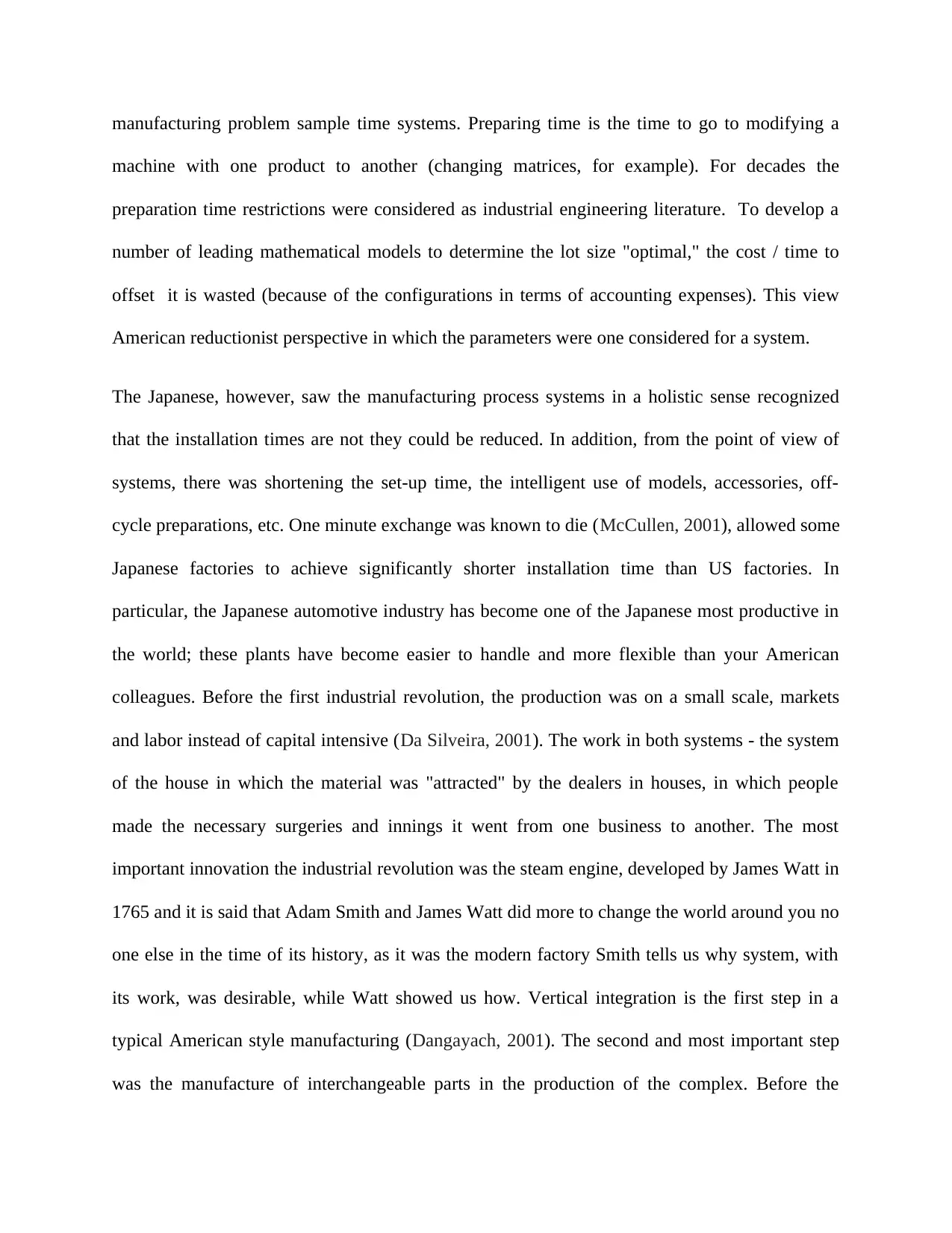
manufacturing problem sample time systems. Preparing time is the time to go to modifying a
machine with one product to another (changing matrices, for example). For decades the
preparation time restrictions were considered as industrial engineering literature. To develop a
number of leading mathematical models to determine the lot size "optimal," the cost / time to
offset it is wasted (because of the configurations in terms of accounting expenses). This view
American reductionist perspective in which the parameters were one considered for a system.
The Japanese, however, saw the manufacturing process systems in a holistic sense recognized
that the installation times are not they could be reduced. In addition, from the point of view of
systems, there was shortening the set-up time, the intelligent use of models, accessories, off-
cycle preparations, etc. One minute exchange was known to die (McCullen, 2001), allowed some
Japanese factories to achieve significantly shorter installation time than US factories. In
particular, the Japanese automotive industry has become one of the Japanese most productive in
the world; these plants have become easier to handle and more flexible than your American
colleagues. Before the first industrial revolution, the production was on a small scale, markets
and labor instead of capital intensive (Da Silveira, 2001). The work in both systems - the system
of the house in which the material was "attracted" by the dealers in houses, in which people
made the necessary surgeries and innings it went from one business to another. The most
important innovation the industrial revolution was the steam engine, developed by James Watt in
1765 and it is said that Adam Smith and James Watt did more to change the world around you no
one else in the time of its history, as it was the modern factory Smith tells us why system, with
its work, was desirable, while Watt showed us how. Vertical integration is the first step in a
typical American style manufacturing (Dangayach, 2001). The second and most important step
was the manufacture of interchangeable parts in the production of the complex. Before the
machine with one product to another (changing matrices, for example). For decades the
preparation time restrictions were considered as industrial engineering literature. To develop a
number of leading mathematical models to determine the lot size "optimal," the cost / time to
offset it is wasted (because of the configurations in terms of accounting expenses). This view
American reductionist perspective in which the parameters were one considered for a system.
The Japanese, however, saw the manufacturing process systems in a holistic sense recognized
that the installation times are not they could be reduced. In addition, from the point of view of
systems, there was shortening the set-up time, the intelligent use of models, accessories, off-
cycle preparations, etc. One minute exchange was known to die (McCullen, 2001), allowed some
Japanese factories to achieve significantly shorter installation time than US factories. In
particular, the Japanese automotive industry has become one of the Japanese most productive in
the world; these plants have become easier to handle and more flexible than your American
colleagues. Before the first industrial revolution, the production was on a small scale, markets
and labor instead of capital intensive (Da Silveira, 2001). The work in both systems - the system
of the house in which the material was "attracted" by the dealers in houses, in which people
made the necessary surgeries and innings it went from one business to another. The most
important innovation the industrial revolution was the steam engine, developed by James Watt in
1765 and it is said that Adam Smith and James Watt did more to change the world around you no
one else in the time of its history, as it was the modern factory Smith tells us why system, with
its work, was desirable, while Watt showed us how. Vertical integration is the first step in a
typical American style manufacturing (Dangayach, 2001). The second and most important step
was the manufacture of interchangeable parts in the production of the complex. Before the
⊘ This is a preview!⊘
Do you want full access?
Subscribe today to unlock all pages.

Trusted by 1+ million students worldwide
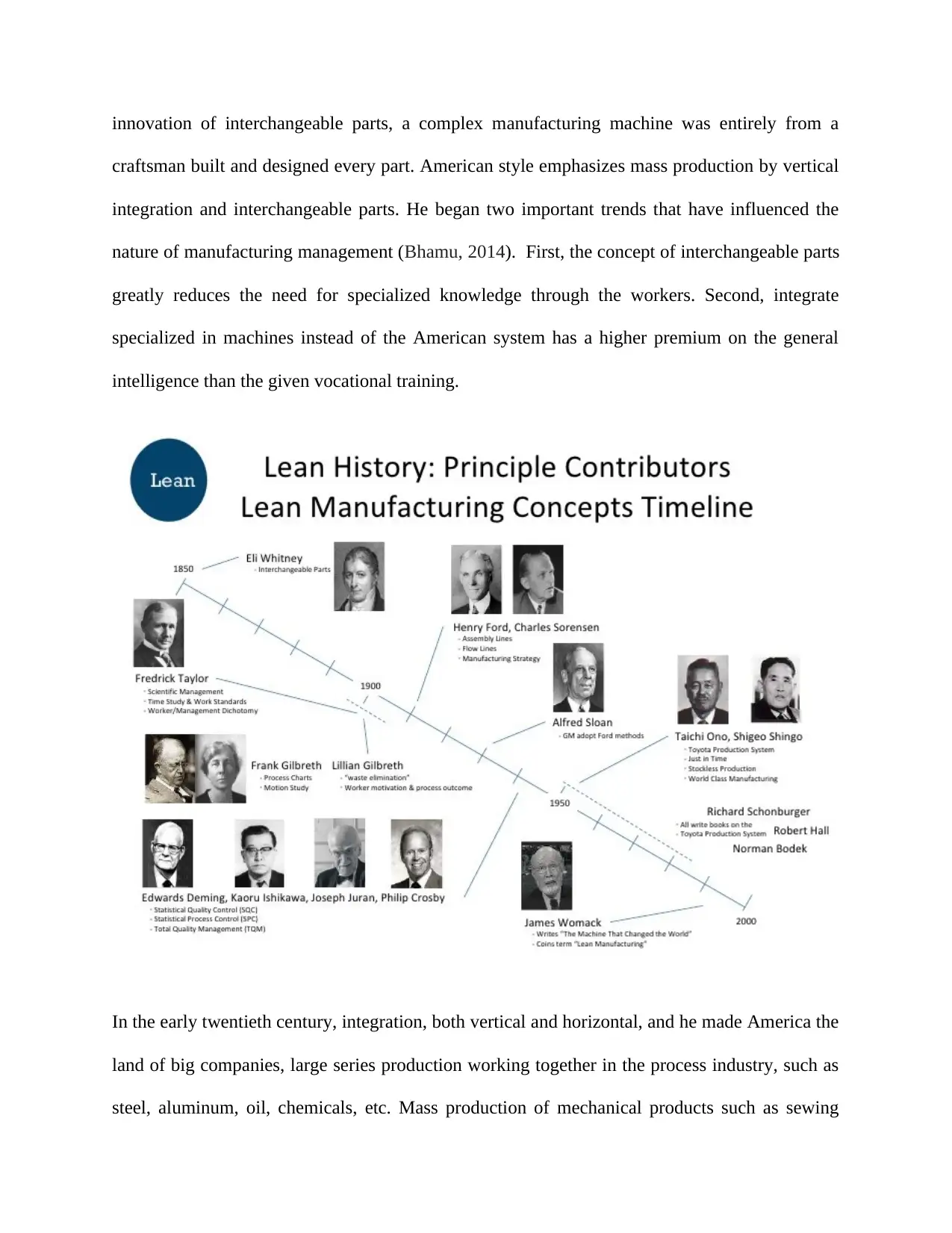
innovation of interchangeable parts, a complex manufacturing machine was entirely from a
craftsman built and designed every part. American style emphasizes mass production by vertical
integration and interchangeable parts. He began two important trends that have influenced the
nature of manufacturing management (Bhamu, 2014). First, the concept of interchangeable parts
greatly reduces the need for specialized knowledge through the workers. Second, integrate
specialized in machines instead of the American system has a higher premium on the general
intelligence than the given vocational training.
In the early twentieth century, integration, both vertical and horizontal, and he made America the
land of big companies, large series production working together in the process industry, such as
steel, aluminum, oil, chemicals, etc. Mass production of mechanical products such as sewing
craftsman built and designed every part. American style emphasizes mass production by vertical
integration and interchangeable parts. He began two important trends that have influenced the
nature of manufacturing management (Bhamu, 2014). First, the concept of interchangeable parts
greatly reduces the need for specialized knowledge through the workers. Second, integrate
specialized in machines instead of the American system has a higher premium on the general
intelligence than the given vocational training.
In the early twentieth century, integration, both vertical and horizontal, and he made America the
land of big companies, large series production working together in the process industry, such as
steel, aluminum, oil, chemicals, etc. Mass production of mechanical products such as sewing
Paraphrase This Document
Need a fresh take? Get an instant paraphrase of this document with our AI Paraphraser
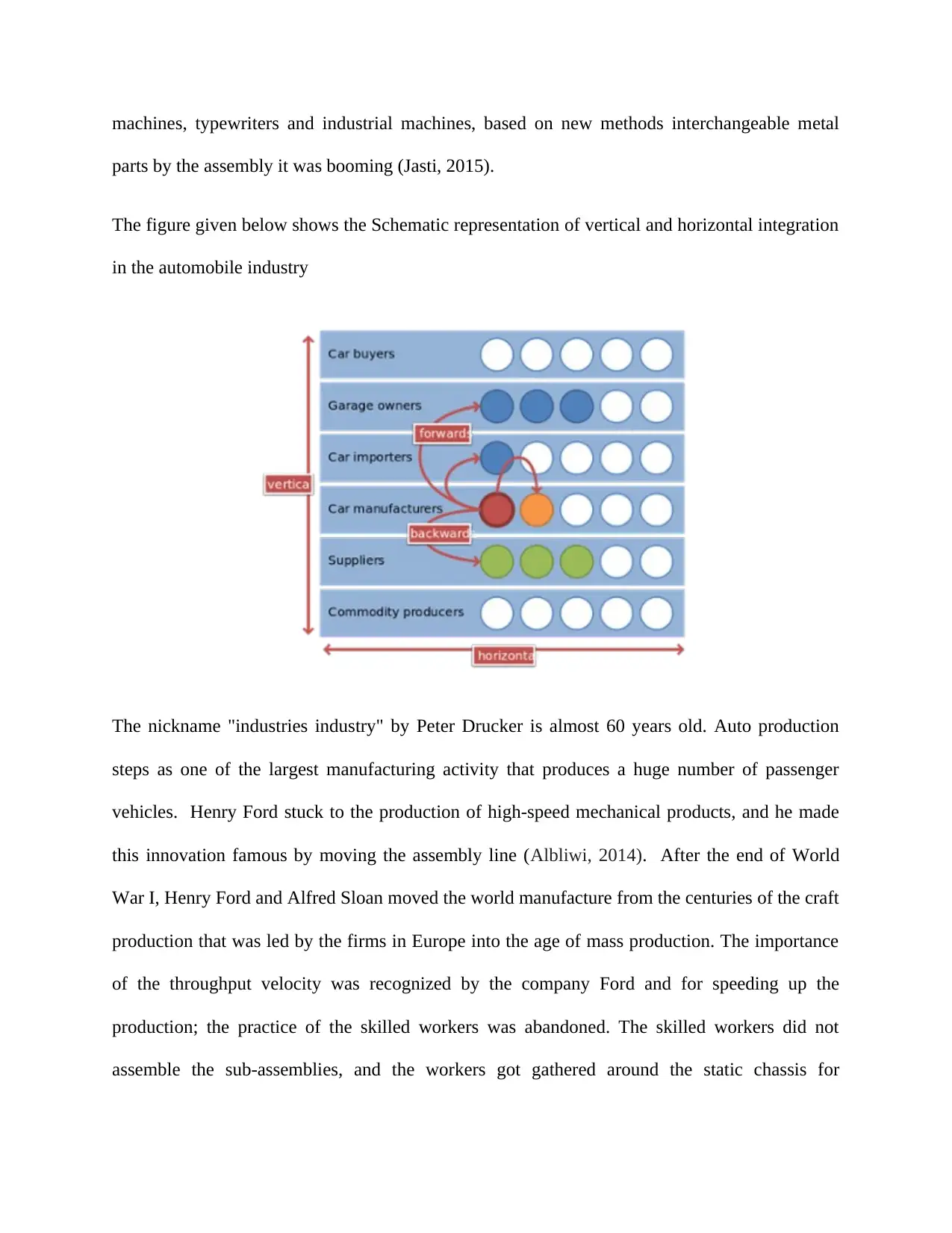
machines, typewriters and industrial machines, based on new methods interchangeable metal
parts by the assembly it was booming (Jasti, 2015).
The figure given below shows the Schematic representation of vertical and horizontal integration
in the automobile industry
The nickname "industries industry" by Peter Drucker is almost 60 years old. Auto production
steps as one of the largest manufacturing activity that produces a huge number of passenger
vehicles. Henry Ford stuck to the production of high-speed mechanical products, and he made
this innovation famous by moving the assembly line (Albliwi, 2014). After the end of World
War I, Henry Ford and Alfred Sloan moved the world manufacture from the centuries of the craft
production that was led by the firms in Europe into the age of mass production. The importance
of the throughput velocity was recognized by the company Ford and for speeding up the
production; the practice of the skilled workers was abandoned. The skilled workers did not
assemble the sub-assemblies, and the workers got gathered around the static chassis for
parts by the assembly it was booming (Jasti, 2015).
The figure given below shows the Schematic representation of vertical and horizontal integration
in the automobile industry
The nickname "industries industry" by Peter Drucker is almost 60 years old. Auto production
steps as one of the largest manufacturing activity that produces a huge number of passenger
vehicles. Henry Ford stuck to the production of high-speed mechanical products, and he made
this innovation famous by moving the assembly line (Albliwi, 2014). After the end of World
War I, Henry Ford and Alfred Sloan moved the world manufacture from the centuries of the craft
production that was led by the firms in Europe into the age of mass production. The importance
of the throughput velocity was recognized by the company Ford and for speeding up the
production; the practice of the skilled workers was abandoned. The skilled workers did not
assemble the sub-assemblies, and the workers got gathered around the static chassis for
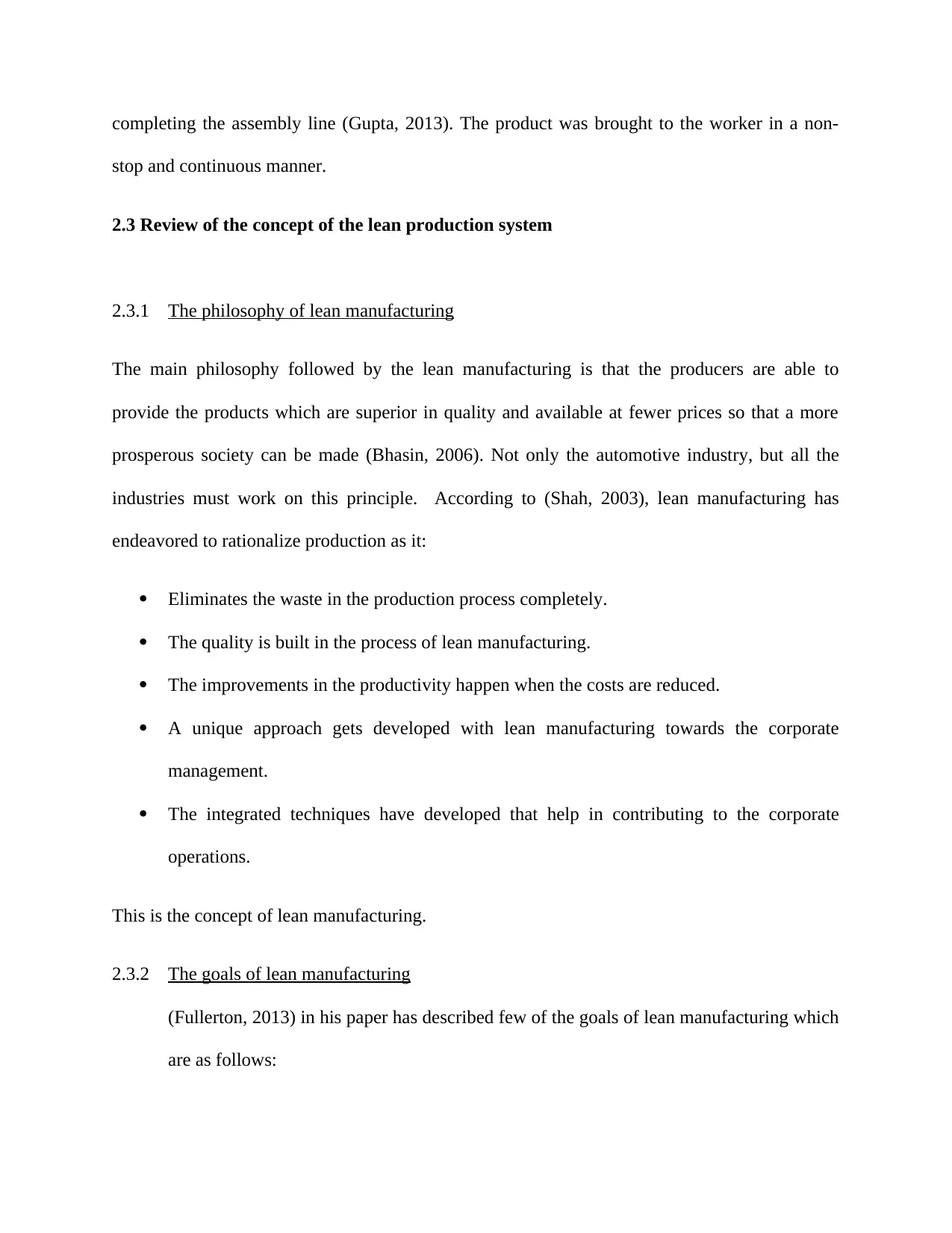
completing the assembly line (Gupta, 2013). The product was brought to the worker in a non-
stop and continuous manner.
2.3 Review of the concept of the lean production system
2.3.1 The philosophy of lean manufacturing
The main philosophy followed by the lean manufacturing is that the producers are able to
provide the products which are superior in quality and available at fewer prices so that a more
prosperous society can be made (Bhasin, 2006). Not only the automotive industry, but all the
industries must work on this principle. According to (Shah, 2003), lean manufacturing has
endeavored to rationalize production as it:
Eliminates the waste in the production process completely.
The quality is built in the process of lean manufacturing.
The improvements in the productivity happen when the costs are reduced.
A unique approach gets developed with lean manufacturing towards the corporate
management.
The integrated techniques have developed that help in contributing to the corporate
operations.
This is the concept of lean manufacturing.
2.3.2 The goals of lean manufacturing
(Fullerton, 2013) in his paper has described few of the goals of lean manufacturing which
are as follows:
stop and continuous manner.
2.3 Review of the concept of the lean production system
2.3.1 The philosophy of lean manufacturing
The main philosophy followed by the lean manufacturing is that the producers are able to
provide the products which are superior in quality and available at fewer prices so that a more
prosperous society can be made (Bhasin, 2006). Not only the automotive industry, but all the
industries must work on this principle. According to (Shah, 2003), lean manufacturing has
endeavored to rationalize production as it:
Eliminates the waste in the production process completely.
The quality is built in the process of lean manufacturing.
The improvements in the productivity happen when the costs are reduced.
A unique approach gets developed with lean manufacturing towards the corporate
management.
The integrated techniques have developed that help in contributing to the corporate
operations.
This is the concept of lean manufacturing.
2.3.2 The goals of lean manufacturing
(Fullerton, 2013) in his paper has described few of the goals of lean manufacturing which
are as follows:
⊘ This is a preview!⊘
Do you want full access?
Subscribe today to unlock all pages.

Trusted by 1+ million students worldwide
1 out of 19
Related Documents
Your All-in-One AI-Powered Toolkit for Academic Success.
+13062052269
info@desklib.com
Available 24*7 on WhatsApp / Email
![[object Object]](/_next/static/media/star-bottom.7253800d.svg)
Unlock your academic potential
Copyright © 2020–2025 A2Z Services. All Rights Reserved. Developed and managed by ZUCOL.





